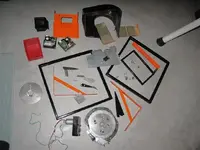I'm not that technically inclined when it comes to machines and stuff like that but I was going to borrow someone elses design I saw on youtube. Basically I would attach a circular disk with penny sized holes in it to a basic motor. The disk spins and the pennies are fed into the hole through a funnel. Then the pennies go over levers with counterweights. The copper coins fall into one bin and the zincs fall into the other. I would make different disks so it could sort any type of coin, not just pennies. Depending on how quickly the lever resets I could get up to 4 coins sorted per second (that's the speed the motor goes - if the lever doesn't go back up quick enough then all the coins would fall into the same bin. Next week I'm going to go to lowes to pick up some supplies. I'll keep everyone posted
Definitely keep us posted!
Given your description, it's the same path I started down when I first learned of this addiction. I had a heck of a good time trying different designs and actually came up with a contraption that was semi-accurate by feeding pennies from four separate Walmart oil change funnels into 3/4" feed tubes then onto a revolving plexiglas disk with 18 holes drilled through it. The pennies travelled over one of four fulcrum type gizmos that were counter balanced to allow the zincs to proceed to reject holes but tripped when the coppers moved over the fulcrums. It was a rollicking good time to watch but not real accurate.
Some points that might save you some aggravation. When you drill your holes in the revolving disk MAKE SURE THEY ARE DEAD ON AS FAR AS BEING ALL THE SAME DISTANCE FROM THE CENTER OF THE DISK. MAKE SURE THE CENTER POINT OF YOUR LEVERS IS AS CLOSE TO THE SAME DISTANCE FROM THE CENTER OF THE DISK AS POSSIBLE. ALSO MAKE YOUR HOLES AS SMALL AS POSSIBLE WHILE STILL ABLE TO ACCEPT YOUR COINS. Trust me, the laws of physics will rear their ugly heads if the your measurements are too far out of whack or your holes are larger than need be. There isn't much difference in the weight of high copper and high zinc pennies and for your levers to be effective the pennies should hit them in the same spot every time. You can fine tune the levers to some extent by your counterweight placement but, try to be as accurate as possible in the hole drilling and lever placement.
One thing that really made fine tuning the lever counterweight easy was using a small rubber stopper (cork shaped), with a wire through it, and the wire attached to the end of the lever. The lever trip point could be very precisely set by sliding the rubber stopper toward or away from the balance point of the lever. I found this much more precise than piling washers on a bolt like in a the Youtube video.
As I said, my Rube Goldberg operation was not real accurate, in part because pennies can vary by weight due to wear and dirt. So a dirty zinc would trip the lever and a worn copper would slide over and into the reject hole. But, that was just my result. You could very well come up with a design that solves that problem.
GOOD LUCK and definitely let us know how you are coming.





